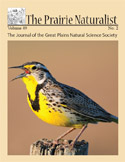Great Plains Natural Science Society

The Prairie Naturalist
Date of this Version
12-2010
Document Type
Article
Citation
The Prairie Naturalist 42(3/4):142~144; 2010, pp 142-144
Abstract
AIlocation of time for feeding, resting and reproduction in subterranean animals is difficult to determine. Although pocket gophers (Thomomys spp.) are among the most widely studied subterranean rodents, there are conflicting reports on activity measurement in these animals. Activity studies have included opening gopher burrows (Tryon 1947), laboratory studies of activity (Vaughan and Hansen 1961), telemetry studies (Anderson and McMahon 1981, Bandoli 1987, and Cameron et al. 1988), and subcutaneously implanted radioactive gold wires (Gettinger 1984). The diversity of techniques reflects the difficulty of generalizing results from different species of pocket gophers in natural and artificial environments. Patton and Brylski (1987) considered alfalfa fields to be food rich environments based on crop density and food availability; therefore, pocket gophers in an alfalfa field should exhibit decreased activity periods because of a reduced search time for food and smaIler home range size. Our objective was to measure daily activity patterns of pocket gophers in a food rich environment. We conducted our study from May 20, 200S through July 30, 200S in an irrigated alfalfa field on the Carnahan Ranches, approximately 9.S km north of the town of Elbert in Elbert County, Colorado. The project foIlowed ASM guidelines (Gannon et al. 2007) and was approved by the Institutional Animal Care and Use Committee at the University of Colorado at Colorado Springs (Approval Number UCCS-04-001).
Included in
Biodiversity Commons, Botany Commons, Ecology and Evolutionary Biology Commons, Natural Resources and Conservation Commons, Systems Biology Commons, Weed Science Commons

